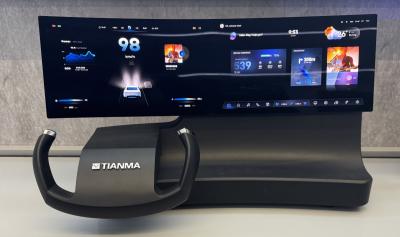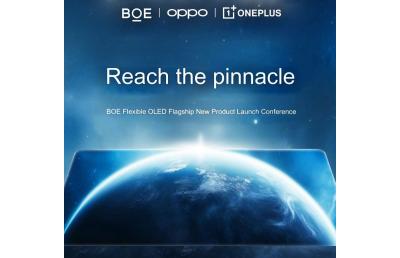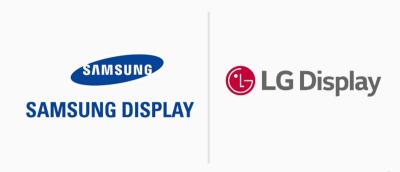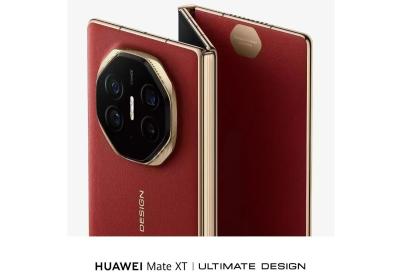AMOLED - introduction and market status
OLED displays use organic materials that emit light when electricity is applied. OLEDs enable emissive, bright, thin, flexible and efficient displays - and so OLEDs are set to replace LCDs in all display applications - from small displays to large TV sets.
An AMOLED display is an OLED display that is driven by an active matrix backplane, it is a type of OLED display that can achieve high performance. Most OLED displays such as the ones used in TVs and smartphones are actually AMOLED displays.

What does AMOLED mean?
The term AMOLED means Active-Matrix OLED. The 'active-matrix' part refers to the driving electronics, or the TFT layer. When you display an image, you actually display it line by line (sequentially) as you can only change one line at a time. An AMOLED uses a TFT which contains a storage capacitor which maintains the line pixel states, and so enables large size (and large resolution) displays.
AMOLEDs today
AMOLED displays today are used in many applications - and are most common in smartphones. Most smartphones today use AMOLED displays (over 50% of smartphones use AMOLEDs rather than LCDs), including the latest Samsung phones, and all of Apple's latest iPhone models.
AMOLED displays are also used in OLED TVs, many wearables (such as the Apple Watch), tablets, laptops, VR headsets, monitors, and more. There are also flexible, foldable (and soon rollable) AMOLED displays available today.
AMOLED vs PMOLED
A PMOLED uses a simpler kind of driver electronics - without a storage capacitor. This means that each line is turned off when you move to the next line. So let's say you have 10 rows in your display - each row will only be on 1/10 of the time. The brightness of each row has to be 10 times the brightness you'd get in an AMOLED. So you use more voltage which shortens the lifetime of the OLED materials and also results in a less efficient display. So while PMOLEDs are cheaper to make than AMOLEDs they are limited in size and resolution (the largest PMOLED is only 5", and most of them are around 1" to 3"). Most PMOLEDs are used for character display, and not to show photos or videos.

Looking to buy AMOLED displays?
Are you looking to buy AMOLED display for your project? AMOLEDs on the market range from small 1-inch ones for smartwatches through large OLEDs used in tablets and laptops - to large TV panels, up to 97" in size. Visit our OLED Marketplace, the world's most comprehensive OLED catalog, where you can browse the available panels, and let us help you find the best AMOLED supplier for your needs!
Further reading
Tianma and Corning show a dual-screen multi-curved color-matched automotive OLED display
At CES 2025, Tianma unveiled a new display prototype that it has developed in collaboration with Corning. This is an automotive OLED display that is made from two 13-inch AMOLED panels. The company says the new display offers "unparalleled visual clarity in automotive applications".
The new OLED display features a unique multi-curvature design, with a left curvature radius of R800mm for optimal driver focus, a middle curvature radius of R1140mm, and a right curvature radius of R2160mm to accommodate the passenger. The system seamlessly bonds two color-matched 13" OLED displays to the multi-curve cover glass made possible with Corning ColdForm technology.
India inaugurates a new AMOLED research center at IIT Madras
The Indian Institute of Technology Madras (IIT Madras) has inaugurated a new research center dedicated for the development of AMOLED technologies. The new AMOLED Research Centre (ARC) is a national centre of excellent that is funded by the Government's Ministry of Electronics and Information Technology (MeitY), by the Indian Defence Research and Development Organisation (DRDO), and Tata Sons.
The goal of this new center is to help India's display manufacturing industry. It will focus on AMOLED displays for wearables, smartphones, and tablets. Researchers at the ARC will also engage in research into OLED TVs, OLED lighting and OPVs.
Huawei launches the Mate 70 smartphone family, the Mate X6 foldable and a new tablet - all with high end AMOLED displays
Huawei announced several new devices yesterday, all with AMOLED displays. We'll start with the Mate X6, a foldable smartphone that offers a 7.93" 120Hz 2240x2440 foldable LTPO AMOLED display, and a 6.45" 120Hz 1080x2440 LTPO AMOLED cover display.
Second is Huawei's new Mate 70 smartphone family, with 3 models. The basic Mate 70 has a 6.7" 2500 nits 120Hz 1216x2688 LTPO AMOLED display, while the 70 Pro and 70 Pro+ both sport a larger 6.9" 1316x2832 LTPO AMOLED displays. The interesting Mate 70 RS Ultimate edition that has a 6.9" 120Hz 3,500 nits 1316x2832 tandem LTPO AMOLED.
Samsung Electronics to order smartphones OLED panels from Tianma as SDC's cannot produce enough to satisfy demand
Yesterday we reported that Samsung Display aims to increase its small-sized and mid-sized AMOLED panels production in 2025 by 10.25% to 475 million panels. It was understood that Samsung hopes to sell more foldable OLED panels and tablet OLED panels.
Today we hear another report that Samsung Display's capacity is totally booked, and the company cannot supply enough smartphone OLED to Samsung Electronics. It is said that Samsung Electronics will order some AMOLED smartphone displays from Tianma to be used in its low-end ranges, the Galaxy M and Galaxy F smartphones.
Huawei expected to order 61 million smartphones OLED panels this year, up 81% from 2023
According to reports, Huawei is enjoying high demand for its AMOLED smartphones in 2024, and it is expected to order 61 million AMOLED panels by the end of the year - up 81% over 2023 (33.7 million).
Huawei suffered from US sanctions in 2019 that drastically decreased its smartphone sales, but in 2023 it has returned to the smartphone market in force, and now it is enjoying very high demand for its smartphones.
BOE launches its Q10 AMOLED display, receives DisplayMate's highest ever rating
BOE launched a new flexible AMOLED display, branded as Q10 AMOLED, that has a new OLED stack and delivers increased performance - the company said that compared to its previous flagship OLED stack, it enhances the peak brightness by 12.5%, the lifetime by 33%, and it reduces the power consumption by 10%. The company also says the color saturation and response time is increased.
The new Q10 display will debut at three smartphones, the OnePlus 13, OPPO Find X8 and Vivo iQOO 13. That specific screen is a 6.8" 3168x1440 (510 PPI) 120Hz LTPO AMOLED. DisplayMate tested the new display, and says it is the world's highest performing mobile display ever, seting or matching 21 performance records. It is the first display to receive DisplayMate's A++ rating.
Does it make sense for LG Display and Samsung Display to merge?
In this article, we examine the theoretical question of whether or not it makes sense for LG Display and Samsung Display to merge, into one company.
Note that we have no indications that such a merger is even considered by the two companies, but we feel this is a fascinating topic that should be explored, and is supported by several strong arguments.
We'll start with a short introduction to the two companies, then see why there are many reasons to pursue a merger, then explain the reasons against a possible merger, and finally detail the current financial situations of both companies.
Samsung Display and LG Display
Samsung Display Corporation (SDC) is a subsidiary of Samsung Electronics. SDC is a leader in OLED production, with a market share of over 40% in the small OLED display market (the second largest player, BOE, holds a market share of around 15%). SDC produces over 300 million AMOLED displays per year - supplying them to Apple's iPhones and tablets, Samsung Electronics Galaxy phones, and many more. The Company also produces larger-area QD-OLED panels for TVs and gaming monitors, and has a capacity of producing around a million TV panels per year. SDC no longer produces any LCDs. SDC does produce microLED displays (but on a very small scale, this is currently a strictly next-gen display technology), and the company develops OLED microdisplays (and also holds OLED microdisplay producer eMagin which it acquired in 2023 for $243 million).
Apple announces its 2024 iPhone 16 series, and the new Apple Watch Series 10, all with AMOLED displays
Yesterday Apple announced its 2024 iPhone 16 series, and its latest smartwatch devices - all based on OLED displays. We'll start with the the iPhone 16 that offers a 6.1" 2,000 nits (HBM) 1179x2556 Super Retina XDR LTPS AMOLED, while the iPhone 16 Plus offers a larger 6.7" 1290x2796 display. Both phones are based on Apple's latest 3nm A18 chipset offering improved performance and AI support.
The iPhone 16 Pro has a more advanced 6.3" 120Hz 2,000 nits (HBM) 1206x2622 LTPO Super Retina XDR OLED. The 16 Pro Max offers a larger 6.9" 1320x2868 AMOLED. These new phones are based on Apple's 3 nm A18 Pro chip, offer a "huge leap in battery life", support Apple Intelligence and feature new a main camera.
Huawei officially launches its Mate XT tri-folding OLED smartphone
Huawei officially announces the world's first tri-folding OLED smartphone, the Mate XT. The phone and its specifications will be unveiled on September 10, and will ship on September 20.
Huawei allows people to reserve their Mate XT phone, and already over 1.25 million people reserved it.
BOE progresses with the construction of its 8.6-Gen flexible AMOLED line in Chengdu
Towards the end of 2023, BOE officially announced its plans for a 8.6-Gen flexible LTPO AMOLED line in Chengdu. The agreement with Chengdu's local government was signed in early 2024, and in April BOE announced it is starting to construct the new fab.
Pagination
- Page 1
- Next page












